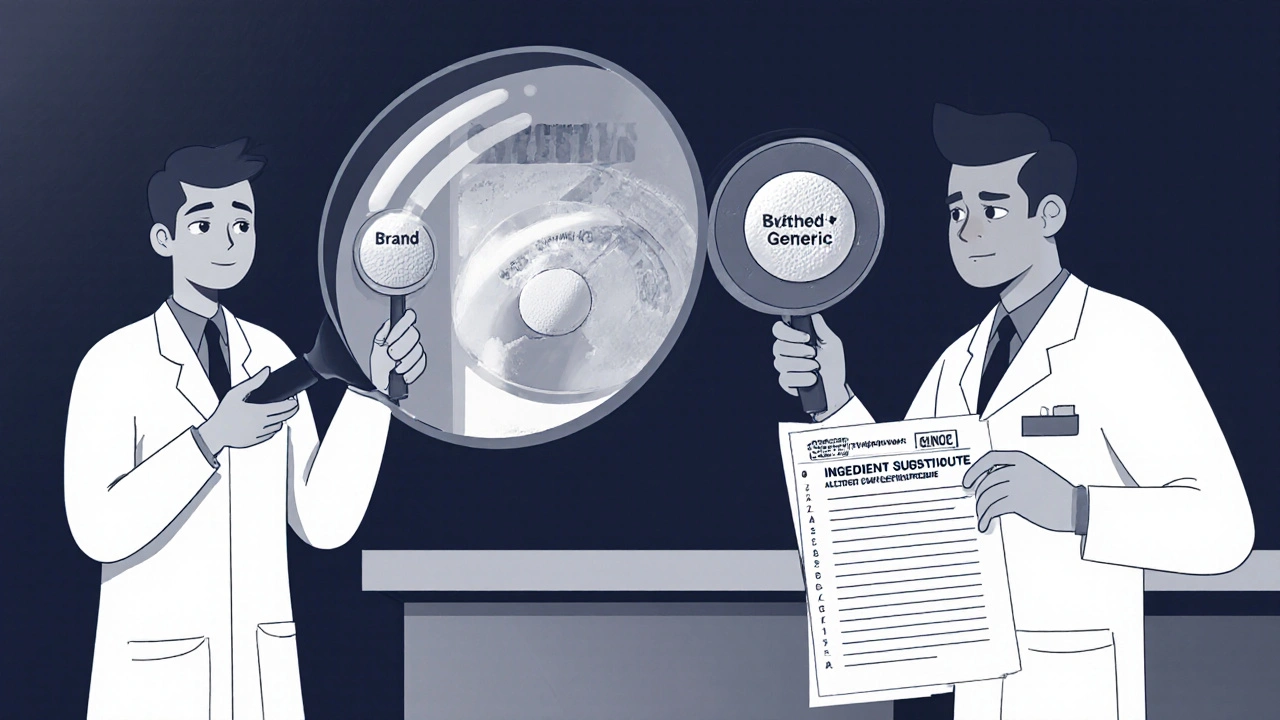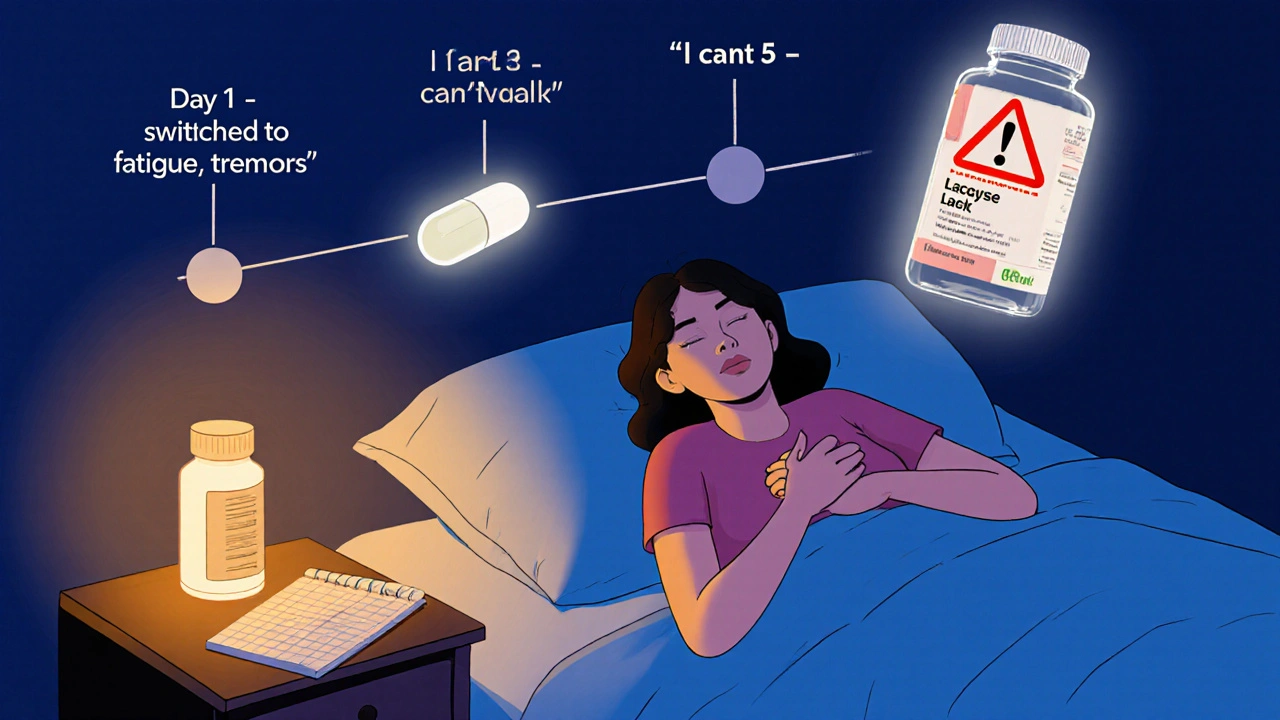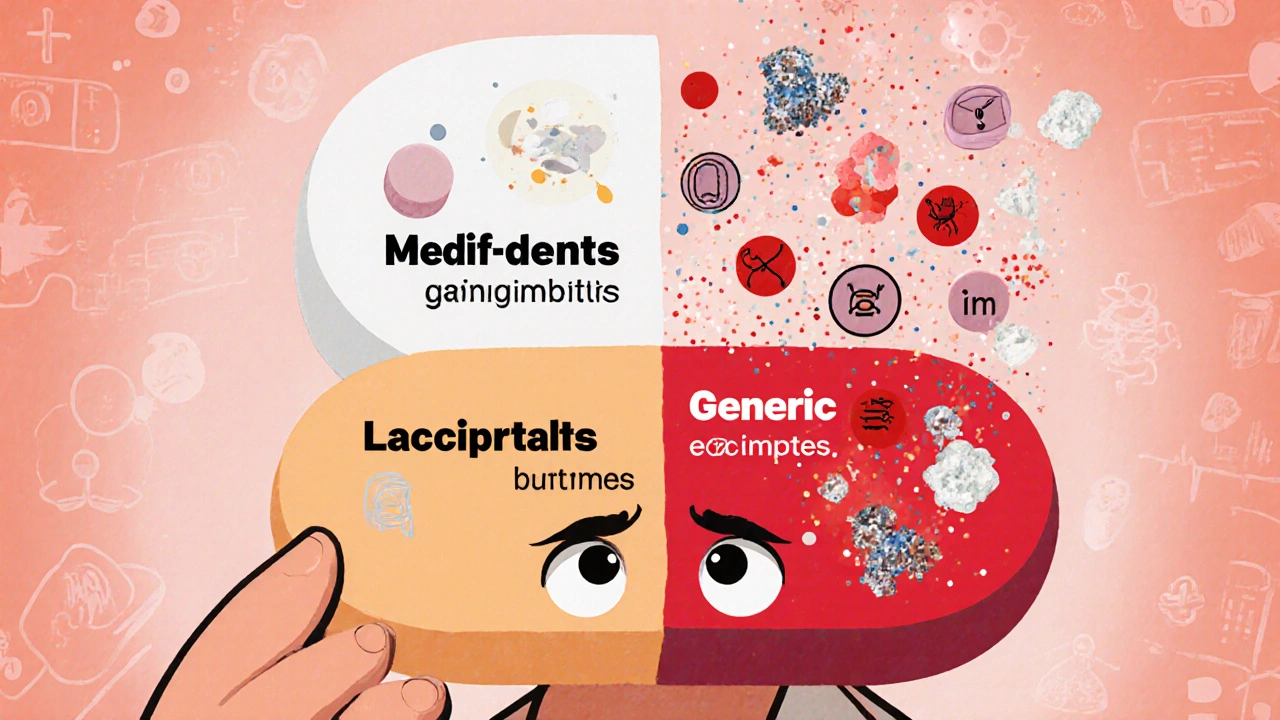Medication Excipient Checker
Check for Excipient Conflicts
Many patients experience side effects when switching to generic medications due to different inactive ingredients. This tool helps identify potential excipient issues based on common intolerances.
Most people assume that if a generic drug has the same active ingredient as the brand-name version, it will work exactly the same way. And for most people, it does. But for a significant number of patients, switching from a brand-name medication to a generic can trigger unexpected side effects - not because the medicine is weaker, but because of what’s not in the pill: the excipients.
What Are Excipients, and Why Do They Matter?
Excipients are the non-active ingredients in medications. They don’t treat your condition. They don’t fight infection or lower blood pressure. But they do everything else: hold the pill together, make it swallowable, help it dissolve at the right speed, give it color, or even preserve it on the shelf. Common excipients include lactose, corn starch, titanium dioxide, croscarmellose sodium, and artificial dyes like FD&C Red No. 40. The FDA requires generic drugs to match the brand-name version in active ingredient, strength, dosage form, and how fast the drug enters your bloodstream. But it doesn’t require them to use the same fillers or coatings. That’s where problems can start. Take lactose, for example. It’s a cheap, common binder used in hundreds of pills. But if you’re lactose intolerant, even a tiny amount can cause bloating, cramps, or diarrhea - and those symptoms can make you think your medication isn’t working. In reality, your gut is reacting to the filler, not the drug. One patient switched from a branded thyroid medication to a generic version and started having severe stomach pain. After checking the ingredients, her pharmacist found the generic contained lactose. The brand did not. Once she switched back, her symptoms vanished.When Switching Medications Can Go Wrong
Not all drugs are created equal when it comes to switching. For most medications - like statins, antibiotics, or blood pressure pills - switching to a generic is safe and effective. But for drugs with a narrow therapeutic index (NTI), even small changes in how the drug is absorbed can be dangerous. NTI drugs include:- Warfarin (blood thinner)
- Levothyroxine (thyroid hormone)
- Phenytoin and carbamazepine (anti-seizure meds)
- Cyclosporine and tacrolimus (immunosuppressants)
- Levodopa (for Parkinson’s)
Real Stories: Allergies, Intolerances, and Hidden Ingredients
It’s not just about how fast the drug works. Sometimes, it’s about what your body rejects. A patient with a known allergy to croscarmellose sodium - a common disintegrant in pills - had no issues with the brand-name furosemide (a water pill). But after switching to a generic version that used the same chemical, she broke out in hives and had trouble breathing. The ingredient was listed on the package insert, but not on the bottle label. She didn’t know to check. Another patient with celiac disease developed chronic diarrhea after switching to a generic antiarrhythmic. The generic used wheat starch as a filler. The brand used rice starch. She wasn’t told. Her doctor assumed the medication was the same. It wasn’t - not in every way. GoodRx’s 2023 survey of 10,000 people found that 12% experienced new side effects after switching to generics. Five percent said the generic just didn’t work as well. For many, the issue wasn’t the drug - it was the dust, the dye, the binder.
How to Protect Yourself
You don’t have to avoid generics. But you do need to be smart about them. Ask your pharmacist. Not your doctor. Not the website. Your pharmacist. They have access to the full ingredient list. Ask: “Does this generic contain lactose? Dyes? Corn starch? Titanium dioxide?” If they don’t know, ask them to check the manufacturer’s data sheet. Keep a medication diary. Note the name of the drug - brand or generic - and any side effects you notice. If you switch and feel worse, write it down. That record can help your doctor or pharmacist spot a pattern. Request “dispense as written”. If you’ve had a bad reaction to a generic, ask your doctor to write “do not substitute” on your prescription. It’s legal. It’s common. And it can save you from a dangerous or uncomfortable switch. Stick with the same generic manufacturer. Generic companies don’t all use the same excipients. One company’s levothyroxine might use cellulose. Another’s might use povidone. If you’ve found a generic that works, try to refill with the same brand. Your pharmacist can help you track that. Check the package insert. It’s not on the bottle. But it’s in the box. Look for the “Inactive Ingredients” section. If you’re unsure what something is, Google it. “Croscarmellose sodium allergy” will bring up patient reports and medical studies.The Bigger Picture: Transparency Is Coming
For years, excipient information was buried. Now, things are changing. The FDA is working on a public database that will list all excipients in both brand and generic drugs - expected to launch in 2026. Generic manufacturers are also starting to advertise “clean excipient profiles” - meaning no dyes, no lactose, no gluten - especially for NTI drugs. In 2024, the Generic Pharmaceutical Association announced voluntary standards for key medications like levothyroxine and warfarin to reduce excipient variability between manufacturers. That’s a big step. But until then, the burden is on you. You’re not being difficult if you ask questions. You’re being informed.
Cost vs. Safety: What’s Worth It?
Generics save the U.S. healthcare system over $370 billion a year. That’s huge. For most people, they’re a win. But for 5-7% of patients, switching causes real harm - not because the drug is bad, but because the packaging isn’t right. If you’re on a low-income plan or Medicare, generics often cost $1-$5. The brand might be $80. But if that $80 pill keeps you from vomiting, sleeping, or walking - it’s worth every penny. There’s no shame in choosing safety over savings. And there’s no reason you shouldn’t have the information to make that choice.What to Do If You Think Your Generic Isn’t Working
If you notice new side effects after switching - or if your condition seems to be getting worse - don’t assume it’s your illness. Don’t assume you’re imagining it. Don’t wait for your next appointment. Do this:- Check your pill. Is it a different color, shape, or size than before?
- Call your pharmacy. Ask for the manufacturer name and the list of inactive ingredients.
- Compare it to your old prescription. Are any fillers new or different?
- If you suspect an excipient issue, ask your doctor to write “do not substitute.”
- Keep a log. Note dates, symptoms, and medication names.
Are generic medications less effective than brand-name drugs?
For most people, generics work just as well. The FDA requires them to deliver the same active ingredient at the same rate and strength. But for about 8% of medications - especially those with a narrow therapeutic index like thyroid drugs, blood thinners, or anti-seizure meds - small differences in how the pill dissolves can affect how well it works. If you feel worse after switching, it’s not in your head.
Can excipients in generic drugs cause allergic reactions?
Yes. While rare, excipients like lactose, corn starch, dyes, and preservatives can trigger allergies or intolerances. One patient developed hives after switching to a generic version of furosemide because it contained croscarmellose sodium - an ingredient the brand version didn’t have. Another had severe stomach issues after switching to a generic thyroid pill that used lactose as a filler. Always check the inactive ingredients if you have known sensitivities.
How do I find out what’s in my generic medication?
The label on the bottle doesn’t list inactive ingredients. You need to check the package insert inside the box, or ask your pharmacist for the manufacturer’s product information sheet. You can also search the FDA’s database or use apps like Medscape or Drugs.com that list full ingredient details. Don’t assume the generic is identical - even if the active ingredient is the same.
Can I ask my doctor to prescribe only brand-name drugs?
Yes. Your doctor can write “dispense as written” or “do not substitute” on your prescription. This legally prevents the pharmacy from switching you to a generic. Many patients with NTI drugs, allergies, or previous bad reactions do this. It’s not uncommon - and it’s not expensive to request.
Why do pharmacies switch me to generics without telling me?
In most states, pharmacists are allowed to substitute generics unless the prescription says otherwise. It’s a cost-saving measure - and it’s legal. But they’re not required to notify you. That’s why it’s important to check your pills every time you refill. If the shape, color, or name changes, ask why.
Are there any generic drugs that are safer than the brand?
Sometimes. Some generic manufacturers use cleaner excipients - no dyes, no lactose, no gluten - and market their products as “patient-friendly.” If you have sensitivities, you might find a generic version that’s actually better than the brand. Always compare ingredients. Don’t assume brand = better.
If you’re on a medication that controls something critical - your heart, your seizures, your thyroid - don’t let cost be the only factor. Your body knows when something’s off. Listen to it. Ask questions. And don’t be afraid to insist on what works for you.

Comments (8)